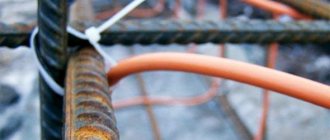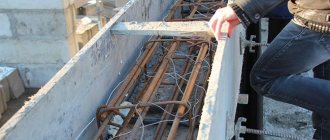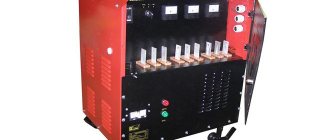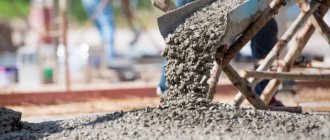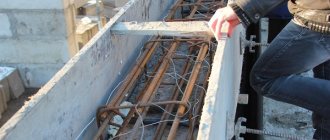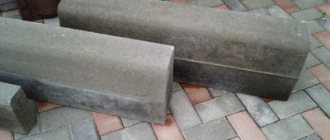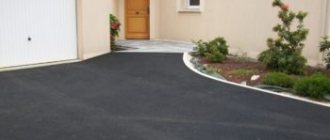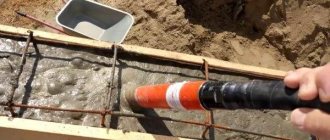When constructing monolithic concrete structures in winter, several technologies are used to create the necessary temperature conditions. This could be the installation of special greenhouses, the use of heat mats or a special wire for heating the concrete. The first method is the most energy-intensive and therefore economically unprofitable; the second option involves the installation of thermal stations that heat only the upper layers, which also introduces a number of restrictions on application. The last option is the most popular and will be discussed in this publication.
Physical hardening process
Concreting is one of the most common technological processes in construction. It is used not only to create foundations, but also various floors, supports and main walls. Hardening of a cement-sand or cement-gravel mixture occurs during a chemical hydration reaction, when water molecules and substances dissolved in it create a new chemical compound.
It is irreversible and is accompanied by the release of a certain amount of heat, which, at positive external temperatures, maintains the interaction of substances during the first seven days after pouring concrete into the formwork.
However, it may not be enough if construction is carried out during the demi-season, and even more so in winter, when outside temperatures drop significantly below zero. In this case, some of the substances do not enter into a chemical reaction, which significantly reduces the actual strength of concrete structures.
In addition, unspent water freezes and expands, destroying them from the inside. To prevent this from happening, various methods of heating the poured mass are used. The simplest and most effective is to lay a heat-generating electrical cable inside the array, which is the PNSV wire.
This is interesting: Water repellent - what it is and what it is like
PNSV wire, device and characteristics
The heating wire PNSV is one steel core (it can be simple or have a zinc protective coating) in a vinyl sheath. Actually, this comes from the decoding of the abbreviation of its name:
- The wire.
- Heating.
- Steel vein.
- Vinyl shell.
It operates due to its resistive qualities: the electrical resistance of steel is quite high, and the longer the conductor, the higher its specific value, as well as the degree of heating when passing electric current.
The industry produces three types of PNSV wires, differing in the diameter of the inner core: 1, 1.2, and 1.4 mm. Their main technical characteristics are shown in the table below.
Types of heating wires
The modern market provides a wide range of such products with different performance characteristics.
The cable heating the concrete must have good insulation, otherwise a short circuit or fire may occur. A good insulating layer helps prevent kinks and fractures. As a rule, such products have one current-carrying core, but they are also found with two conductors.
Types of wire for heating concrete and their features:
- PNSV is the most accessible and well-known type. It has an attractive price, starting from 1 ruble per meter. Reusable use is possible, but can only be used with a transformer.
- The PTPZh wire is similar in technical characteristics to the PNSV, but it has two cores.
- KDBS - two-wire in sections. Expensive. Can be used without a transformer. Very easy to install and install. Applies once.
- VET - with two steel wires. Economical. You can work with it without a transformer.
https://youtube.com/watch?v=ITujT-WErts
In addition to products that heat concrete structures, there are series of heating wires used for other purposes. They can be resistive or self-regulating. Resistive conductors include the simplest ones, which are used in the construction of heated floors, as well as for heating pipes with a diameter of up to 40 mm. Large pipes and roof heating are carried out using a self-regulating cable, which independently regulates heating without sensors, reacting to temperature changes.
Application of heating elements
Negative temperatures crystallize water in concrete, and hydration of the material stops.
When frozen, the liquid expands and breaks the bonds formed in the cement. Even if the temperature rises, the material will no longer reach the required strength. At a temperature of 20 °C, optimal and uniform hardening of the composition occurs, and its important characteristics are preserved. To maintain the required technical conditions in winter, PNSV concrete heating cable and its analogues are used. It can be useful in the following situations:
- thermal insulation of the formwork and monolith is not fully ensured;
- the monolith has large dimensions and cannot warm up evenly;
- work is carried out at negative temperatures, and water freezes in the solution.
Features of the design of wires for heating concrete
Appearance of the PNSV wire and its design
They are mostly single-core and in appearance practically do not differ from cables. Withstands winter concreting temperatures down to -20°C. The maximum current level during the heating process is 16 A. The variety of core cross-sectional sizes (from 0.6 to 3 mm) guarantees the flexibility of the heating system and makes it possible to create various wire laying patterns. To heat one cube of concrete solution, 55 m of cable is required.
The conductor is a steel wire with a diameter of 1–3 mm. To insulate the cable under standard conditions, heat-resistant film made of polymer materials is used. Its thickness ranges from 0.5–1 mm. This coating can withstand temperatures of 170–180°C. The insulating braid made of silicone and fluoroplastic is resistant to prolonged heating (170–220°C).
Installation of PNSV
The layout of the PNSV wire must be thought out at the design stage of the facility. The main thing is its installation in the formwork before pouring the concrete solution begins. In most cases, aluminum wire is used to attach the wire to the fixture.
To ensure that the heating of the concrete mixture is as uniform as possible, the sections are mounted at an equal distance from each other both vertically and horizontally. The distance between adjacent ones should be about 15 centimeters.
It is important to note that if the network voltage is 380 volts, the length of the segment should be 31 linear meters, if 220 - 17 meters. Only in this case will the mixture be heated evenly, which means it will achieve the maximum possible strength. If the section is mounted longer, the thermal energy will not reach the most remote areas.
It is important to remember that connecting the wire to the network must be done outside the formwork.
In most cases, this is achieved by connecting a cable with aluminum cores and wrapping it tightly. When the concrete mixture has completely hardened, the wire cannot be pulled out of it; it remains inside forever and can subsequently be used as a “warm floor.”
Warm-up technology
The locations of communications and the location of holes in the concrete surface must be thought out before starting to pour the composition. After installing the system and covering it with a cement mixture, any work on the surface may damage the wires. For example, before diamond drilling into a material, you need to make sure that the hole will not pass through the concrete heating cable.
Rules for laying the system
Before placing the heating system, reinforcement and formwork are installed. Then the PNSV layout is carried out; there should be an interval of 8-20 cm between the turns of wires. The size of the gap depends on the wind, outside temperature and humidity.
The cable is attached with clamps to the fittings, without tension. The optimal radius of bends is more than 25 cm. The current-carrying conductors should not intersect, the distance between them is 1.5 cm, this arrangement avoids short circuits.
Most often, the wire for heating PNSV concrete is laid according to the “snake” pattern, which is used for installing heated floors. This method saves cable and allows you to cover the maximum area of the concrete base.
The following points must be checked before pouring the solution:
- the temperature of the prepared mixture is above +5 °C;
- there is no ice in the formwork;
- the circuit is connected correctly;
- cold ends have an optimal length.
The PNSV cable comes with instructions, which are important to follow when installing the heating system. There are two options for connecting via busbars - star and delta. In the first method, three cables of the same type are combined into a node, then the free three contacts are connected to a transformer. The power supply is located at a distance of up to 25 m from the connection point. The area of material that will be heated is protected by a fence.
The system is connected only after the solution has been poured. The use of a heating cable for concrete PNSV includes the following steps:
Warming up is underway; the temperature should increase by 10 °C per hour. High speed will disrupt the uniform heating of the material.- Heating is carried out at a constant temperature value. Concrete needs to gain half of its technological strength. The optimal temperature is 60 °C, the maximum possible is 80 °C.
- The material cools slowly. Its cooling rate should not exceed 5 °C per hour, otherwise cracking of the structure will occur.
If all work was carried out correctly , then the concrete will reach the appropriate strength grade. After heating, the cable remains in the material and plays the role of an auxiliary reinforcing structure.
VET and KDBS cables can be connected through a socket or panel board to a 220 V network; they are also divided into sections, which prevents overloads. But their cost is significantly higher than PNSV wires.
For the construction of large objects, such costs are unprofitable, so a cheap analogue is often used.
Concrete can also be heated using a tubular electric heater (TEH) and electrodes. The fittings are inserted into the solution and connected to a power source - a welding machine or other step-down transformer. This option does not require a heating cable, but will require significant energy expenditure. Water acts as a conductor in concrete, and as the material hardens, the resistance will increase.
Calculation of the length of the PNSV
Several factors influence the determination of the length of the PNSV cable. The amount of heat that will be applied to the material for hardening is of great importance. This indicator is affected by thermal insulation, air temperature, shape and size of the structure, and humidity.
The length of the loop should be on average 28−36 m. If the temperature is above -5 °C, then laying is done in increments of 20 cm. When cooling, every 5 degrees the gap between the cores is reduced by 4 cm. At around -15 °C it will be equals 12 cm.
The power consumption of the PNSV cable is also important; it depends on the diameter:
- 1.2 mm - 0.015 Ohm/m;
- 2 mm - 0.044 Ohm/m;
- 3 mm - 0.02 Ohm/m.
The operating current cannot exceed 16 A. It is necessary to calculate the power consumption per meter of wire.
To do this, the squared current is multiplied by the resistivity. The total power is found from the product of the obtained value and the total length of the wire. The transformer voltage is calculated in a similar way. The current is multiplied by the resistance to get the operating voltage.
PNSV wire is the cheapest option for heating concrete mix. But its use requires special equipment and relevant knowledge. Thermal insulation also reduces the cost of heating the material and improves the quality of concrete due to uniform cooling.
This is interesting: Color for concrete - what types of dyes there are
Welding machine as a step-down transformer
When pouring a small volume, the wire for heating concrete can be connected to a powerful welding machine with an output current of 150-250A. This will save on renting a step-down transformer. Let's give an example of how this method can be implemented.
Task: pour a slab with a volume of 3.6 m3, at an air temperature of 10°C.
Required:
- welding machine 200−250A;
- current clamps;
- PNSV wire;
- Automatic reclosure for cold ends;
- fabric-based electrical tape.
PNSV must be cut into segments of 18 m each. Each such segment can withstand current up to 25A. You can connect 10 such segments to a 250A welding machine (25×10=250A). But in order to prevent overload, it is worth leaving some reserve, so we will take 8 segments.
We screw the autorecloser to each output and insulate the connection point. The length of the wire should be enough to reach the welding machine, and the twist itself should be placed in concrete.
Next, the PNSV is laid according to the diagram below. The cold ends are connected by a terminal block ((+) and (-) separately), which is placed on an insulating material, for example, textolite.
Connection diagram of PNSV to the welding machine
Having completed pouring the concrete, we set the minimum current on the welding machine and connect the terminals to its forward and reverse outputs. We measure the current on all segments; it should be no more than 20A. During heating, the current will drop, then we increase it on the device.
Features of PNSV heating wires
The PNSV cable is a steel core with a diameter of 1.2 to 3 mm and a cross-section of 0.6 to 4 mm
2
, covered with PVC or polyester insulation. Thanks to this insulating material, the wire does not bend or break and is resistant to fire.
Most often, electric heating is carried out using wires with a minimum diameter of 1.2 mm. However, practice shows that it is better to use 3 mm PNSV, especially if you plan to manually compact the mortar. The fact is that the insulation of such a cable will be much stronger, so in the event of poor-quality power supply, the likelihood of overheating will be minimal.
It is also worth paying attention to another distinctive characteristic of heating cables of this type - the presence of “cold ends”. These branches extend beyond the boundaries of the concrete slab. For “cold ends”, automatic reclosure wires (aluminum conductors) are used, connecting the cable itself to the supply route.
Installation of a wire that heats the concrete solution
There are different layouts for laying heating cables. But they all have the same things in common:
Installation of a heating cable when pouring a concrete slab
- They are connected to the voltage source through "cold ends". The core must have a minimum resistivity value.
- To improve the quality of heating the solution, the cable is wrapped in foil. Thanks to this, heat transfer increases and the concrete hardening period is reduced. This option is well suited for small volumes and areas.
- The minimum distance between adjacent “lines” of wires in the heating circuit should be 1.5 cm. Overlaps are not allowed. If these rules are not followed, then the cable sheath will melt.
- The temperature regime at which it is necessary to install the heating system for concrete mortar should not be less than -15°C.
At very low temperatures, the insulation may crack or break, causing a short circuit.
Related video: Cable for heating concrete without a transformer
Installation of sectional heating cable
Heating wire in the formwork
When installing a sectional heating cable, there is no issue with cutting, since the heaters are sold in ready-made sections, and not in coils. For concreting in winter, it is necessary to calculate the power of the heating element based on the concrete cubes used in the monolithic concrete structure.
The TMO technology for concrete is accompanied by instructions, which indicate that for heating 1 cubic meter. the building mixture will require from 500 to 1500 W. It all depends on the weather conditions outside. If you use a few simple technical techniques, you can significantly reduce your energy costs:
- pre-insulate the formwork;
- use special nozzles for the mixture that allow you to lower the freezing point of the solution.
If floors or beams are to be poured, the required material is calculated based on 4 linear meters for each square meter of surface. If three-dimensional structures are to be erected, for example, I-beams of concrete, electric heating is laid in tiers with an interval of no more than 0.4 meters. The protection of the heating wires allows them to be securely wound to the fittings.
The interval between the electric heater and the surfaces of the structure must be at least 20 cm. For uniform heating, the distance between the cables must be the same.
Advantages and disadvantages of segmented cable
KDBS cable for heating concrete
Segmented wires have undeniable advantages in comparison with their analogues:
- simple calculation of the length of the required heating element, ease of installation;
- the probability of electric shock is minimal;
- To organize the heating of building materials, the additional use of expensive equipment is not required.
The disadvantages include the relatively high cost.
Principles of use
The technological map of this process should take into account the following nuances:
- The cable cores are made of steel, which has a high resistivity, which means it gives off more heat. In air at such temperatures, the insulation melts, so direct connection of the heating cable to the network is carried out using a conductor with lower resistivity.
- The minimum distance between wires is 15 mm. Otherwise, all the insulation will melt.
- The cable is laid like a snake. The minimum radius of curvature is 25 mm.
- The minimum air temperature at which work can be carried out: -15 degrees Celsius, since the insulation of most wires is made of plastic, which loses its flexibility. As a result, it may crack.
- To ensure uniform heating, the wires are covered with foil.
- Warming up is carried out in stages.
Why is concrete heating needed?
During the cold season, when the ambient temperature drops below the freezing point of water, problems arise with the hydration of the concrete solution. Simply put, the mixture partially freezes rather than completely hardens. After the ambient temperature rises, the thawing process begins, the solidity of the mixture may be disrupted, which will negatively affect the solidity of the structure, its resistance to water penetration, which will lead to a decrease in durability.
Consequences of pouring mortar in the cold, in this case even the Aquabarrier waterstop or other waterproofing will not help
To avoid these consequences, it is imperative to electrically heat the concrete mixture in winter. In this isothermal process, there are no disturbances in its structure, which has a positive effect on the strength of the structure being built.
Types and characteristics of cables
There are several types of heating cable for heating concrete, the most popular is PNSV. It is based on a steel core with a cross-section of 0.6-4 square meters. mm and 1.2−3 mm in diameter. Some models are galvanized, which protects the wire components from aggressive components of building mixtures.
The heat resistance of the cable is provided by polyester or PVC insulation. It is also not afraid of aggressive components, abrasion and kinks, has increased resistivity and a durable structure. Technical parameters of the PNSV cable:
- about 60 m of wire is enough for 1 cubic meter of solution;
- resistivity 0.15 Ohm/m;
- use of the element up to -25 °C;
- Possibility of installation down to -15 °C;
- stable performance at temperatures from -60 °C to +50 °C.
The cable is connected to the cold ends using an aluminum recloser wire.
A three-phase 380 V network is suitable for power supply; connection to a transformer is possible. If the cable length is more than 120 m and the calculations are carried out correctly, then a household network of 220 V can also be used. The operating current passing through the thickness of the concrete should be 14-16 A.
An alternative element for heating building mixtures can be a PNSP cable. Its insulation consists of polypropylene, which slightly increases the heat dissipation rate compared to PNSV products. These types of cables can also be used for underfloor heating equipment.
For proper operation of the heating element, you need to accurately calculate the length of the cable. Minor defects can be corrected by the incoming voltage from the transformer, adjusting its level.
PNSP and PNSV wires can only work together with equipment for adjusting the heat transfer power. This can make things more difficult. The way out of the situation is sectional two-core thermal cables with self-regulation VET and KDBS. They can be connected to a 220 V network directly. Linear power is 40 W/m for the KDBS wire and 35-45 W/m for VET. The permissible bending radius is 35 mm for the first model and 25 mm for the second, respectively.
Heating concrete with a 220 volt cable: features
To ensure that the solution poured into the formwork sets properly, a KDBS is used - a 220-volt heating cable for concrete. This is a two-core resistive heating cable, complemented by a connecting wire and a connector for connecting to the mains.
It is effective in the temperature range from +5*C to -30*C and can be used not only for monolithic work, but also for temporary heating of the entire construction site.
Heating concrete using a heating cable has many advantages:
- The concreting process at low temperatures accelerates, and the concrete does not freeze.
- It is possible to maintain a high pace of construction work, reducing time and labor costs.
- This is an economical solution that does not require significant financial investments.
- Installation of a heating cable for concrete does not require the use of special equipment, is carried out without a technological map and can be carried out directly by specialists from a construction company.
- To connect the line, a step-down transformer is not needed, since the concrete is heated with a 220-volt wire.
- The maximum cable heating temperature is 60*C, which provides optimal conditions for concrete hardening. It does not overheat and does not boil, which means that so-called “sinks” and voids are not formed in it, reducing its strength.
- Heating of concrete at 220 V is carried out using heating sections, which guarantee uniform heating over the entire area of the poured structure.
- The use of KDBS is absolutely safe, since the high-strength insulating coating reliably protects the steel core from mechanical damage.
Post-processing of concrete
Such a short period of time for warming up the concrete mass prompts many novice builders to ask whether it is possible to cut and drill concrete before it reaches its original strength.
In fact, you can cut it, but only taking into account one nuance. If you plan to cut with a diamond tool that eliminates the formation of cracks and uneven edges of the holes, then nothing critical will happen. But you will have to wait with impact loads until the concrete meets the required strength grade.
Length calculation
To calculate the length of the PNSV wire for heating concrete, several main factors must be taken into account. The main criterion is the amount of heat supplied to the monolith for its normal hardening. It depends on the ambient temperature, humidity, the presence of thermal insulation, volume and shape of the structure.
Depending on the temperature, the cable laying pitch is determined with an average loop length of 28 to 36 m. At temperatures down to -5°C, the distance between the cores or pitch is 20 cm, with a decrease in temperature for every 5 degrees, it decreases by 4 cm, at - At 15°C it is 12 cm.
When calculating the length, it is important to know the power consumption of the PNSV heating wire. For the most popular diameter of 1.2 mm, it is equal to 0.15 Ohm/m; for wires with a large cross-section, the resistance below a diameter of 2 mm has a resistance of 0.044 Ohm/m, and 3 mm – 0.02 Ohm/m. The operating current in the core should be no more than 16 A, therefore the power consumption of one meter of PNSV with a diameter of 1.2 mm is equal to the square of the current and the resistivity and is 38.4 W. To calculate the total power, you need to multiply this figure by the length of the laid wire.
The voltage of the step-down transformer is calculated in a similar way. If 100 m of PNSV with a diameter of 1.2 mm are laid, then its total resistance will be 15 Ohms. Considering that the current is no more than 16 A, we find the operating voltage equal to the product of the current and the resistance; in this case it will be equal to 240 V.
The use of PNSV wire is one of the cheapest ways to heat concrete. But it is more suitable for use by professional builders, since its connection requires special knowledge and equipment. This cable can also be used at home if you correctly calculate the power consumption. The use of thermal insulation materials will help reduce costs when heating the solution; in this case, heating will occur faster, and the temperature decrease will occur more evenly, which will improve the quality of concrete.
Rent of generator 60 kW AD-60S-T400-R
- Type: diesel
- Power: 60 kW
- Voltage: 380V
- Tank volume: 175 l
- Working time: 10 h
- Rent from 5 days
Day
Month
Pledge
5 000.-
130 000.-
200 000.-
Check availability: By phone.
Call or send a request via SMS or WhatsApp number.
By email
24/7 acceptance of orders by email: no waiting and guaranteed processing. You will receive an accurate calculation of your order for renting equipment and tools by email or using the contact information you provided.
Rent with operator: +5 000 .- /day
Pros and cons of PNSV
Heating concrete in this way is quite beneficial. This is explained by both the low cost of the wire and the relatively low electricity consumption. Separately, it is necessary to note the resistance of the wire to alkaline and acidic influences, which allows the use of this method when adding various additives to the mixture.
Main disadvantages:
- complexity of calculations when calculating the length of the wire;
- the need to use PT.
Step-down stations are quite expensive, and given the length of the process, it is not profitable to rent them (such services cost 10% of the cost of the product). The use of welding machines makes it possible to heat small structures, but since it is not designed for this mode of operation, its failure and subsequent expensive repairs are quite likely.
Operating principle and types of wires
After installing the reinforcing frame, the heating cable is placed directly on the working surface. The cross-sectional area and maximum allowable stress depend on the specific situation. Then the concrete mixture is poured, followed by connecting the heating cable to the power supply network (or transformer). The concrete gradually heats up, begins to harden faster and (most importantly) evenly. The structure remains homogeneous, therefore eliminating the possibility of bubbles and cracks.
Three main types of cables are used to heat concrete:
- A two-core cable for concrete in sections (KDBS) can be switched to a 220 V electrical network, so there is no need to use a step-down transformer. Of the three products, it is much easier to install, no trimming is required, and the presence of convenient couplings ensures easy installation according to the desired pattern. On the other hand, KDBS has a high cost (from 1000 rubles per 1 linear meter). The second disadvantage is related to single use. Once the concrete mixture has hardened, it will not be possible to dismantle the product.
- Two-core cable made by Finnish BET. Again, it does not require a step-down transformer and is connected directly to the mains. It is characterized by efficiency, and to heat one cube of concrete mass, no more than 20-25 linear meters are needed.
- A single-core heating wire with a steel conductor and polyvinyl chloride insulation (PNSV) is the cheapest product for heating the concrete mass (about 20-50 rubles per 1 running meter), therefore it is most used in the construction of private houses. The power supply circuit must have a step-down transformer. However, if a number of conditions are met, direct switching to the network is possible. After the concrete has been heated, the wire can be reused (as a “warm floor” or an “anti-ice” system).
Let's take a closer look at the most popular and simple PNSV wire.
Features of PNSV heating wires
Structurally, the product consists of one steel core, the diameter of which ranges from 1-3 mm. The cross-sectional area of a round conductor can reach 4 square meters. mm. Polyvinyl chloride or polyester is used as insulation, which eliminates strong kinks, protects the wire from fractures and increases resistance to fire.
The most common are wires of small diameter - about 1.2 mm, but since the cost of the product is minimal, it is better not to save money and take a 3 mm PNSV cable. This is especially true if you plan to manually compact the cement mortar. In this situation, the insulation will be much stronger, so even during power failures, the possibility of overheating is eliminated.
Be sure to pay attention to another distinctive characteristic of heating cables - cold ends. These structural parts are located outside the concrete slab, and for their production they use conventional aluminum current-carrying conductors (ACV). Their main task is to connect the heating cable embedded in concrete with the electrical network.
Features of KDBS and VET cables
PNSV is not ideal, and the main disadvantage of the heating cable is associated with the extreme need to use additional equipment - a transformer used to lower the voltage and regulate the power of heat generation. Simply put, to prevent the device from burning itself out, you have to reduce the voltage.
The use of two-core sectional conductors simplifies the task of heating the concrete mixture. These products are characterized by self-regulating properties. We are talking about the domestic KDBS or the Finnish VET. There is no need to connect additional devices for heating. It is enough to switch to a 220 V electrical network and enjoy the result.
In the image below you can see the cable structure for heating concrete:
Let's decipher the notation:
- A – stripped heating cores;
- B – cold termination (regular installation cable, for example, with aluminum conductors, which is necessary for connecting to the network, but is not used as a heating element);
- C – coupling for fixing the installation cable with heating sections;
- D – end sleeve for insulation;
- E – heating cable for heating concrete of a specified length.
The design of the Finnish VET cable is almost identical to KDBS, but the technical and operational characteristics are still different. Their comparison is shown in the table below:
| Parameter name | VET | KDBS |
| Operating voltage, V | 220-230 | 220-240 |
| Linear power, W/m | 35-45 (depending on model and length) | 40 |
| Insulation resistance, Ohm | 103 | 103 |
| Bending radius, mm | 25 | 35 |
| Diameter, mm | 6 | 7 |
| Heating section length, m | 3,3-85 | 10-150 |
| Dust and moisture protection class | IP67 | IP67 |
To mark domestic heating cables KDBS, the general marking scheme AAKDBS BB is used, where AA is the linear power value, BB is the length of the heating section. For example, if you see the marking 40KDBS 20, then it indicates that the power of one linear meter of this cable is 40 W, and the length of the heating section is 20 m.
Laying scheme
The main requirement is uniform heating; there should be no cold zones. The minimum distance between adjacent wires for heating concrete is 15 mm, the maximum is selected taking into account the characteristics and external conditions. The optimal horizontal gap is considered to be 20-40 cm, vertically - 8-10, it is not recommended to exceed it. The entire volume of the mixture and the main dimensions of the structures are taken into account.
The simplest design is a “snake” with a bending radius of at least 5 working diameters for PNSV and 10 for PTPG. It is placed along the reinforcement without tension (ideally with fixation with plastic clamps), overlaps and exits to the surface (the recommended distance to the edges is from 20 mm), the integrity of the insulation is monitored. Direct contacts of bare areas with mesh or metal rods cause a short circuit; in particularly dangerous places, laying with pieces of bitumen-impregnated paper or roofing felt is provided.
An unregulated wire is connected to a step-down transformer, special attention is paid to the cold ends, the current supply conductors must have a lower resistivity value than the heating ones, aluminum meets this requirement. When choosing a "triangle" circuit, the wires are divided into three equal groups, connected in parallel and combined into three output points
When distributing the load with a “star”, three segments of equal length at one end will be connected into one node, the rest - to the power station. All contacts are reliably insulated; for these purposes, double-sided electrical tape or heat-shrinkable tubes are used. The power of the transformer for heating is determined by the calculation; on average, 1 kW is required for 0.4-1 m3 of concrete.
Laying KDBS follows the same principle, but in slightly larger increments (consumption is 4 lm per 1 m2 along a screed or horizontal plane) and with direct connection to an outlet. It is completely immersed in concrete, only the supply terminal remains outside. Despite the higher cost of the cable and the increase in power consumption to 1.5 kW per 1 m3, this type provides the most uniform heating and stable performance characteristics. Once dry, it is simply cut off and left in the concrete. KDBS is selected for critical areas, when carrying out urgent repairs, with a large number of individual monolithic elements, or the need to use a vibrator. It is easier to install it for people without experience; the factory parameters exclude overheating or burnout.
Basic rules of heating technology:
- The minimum temperature of the poured composition is +5 °C.
- Power is supplied exclusively to wires buried in concrete, ideally through a voltage stabilizer.
- Due to cracking of the insulation, installation is not recommended at temperatures below -15 °C.
- The process is carried out with power control: smooth heating for the first 2 hours, maintaining within 50-60 °C for at least 3-4 days, gradual cooling.
Heating cable price review
Single- and double-core cables are sold in coils:
| Marking | Insulation material | Diameter of conductor, mm | Electrical resistance, Ohm/m | Coil length, m | Price per 1 linear meter, rubles |
| PTPZH 2 | High pressure polyethylene | 0,6 | 0,55 | 500 | 4,5 |
| 1,2 | 0,14 | 4,9 | |||
| 1,4 | 0,1 | 5 | |||
| PNSV 1 | Polyethylene or PVC | 1,2 | 0,15 | 1000 | 1,3 |
| 2,0 | 0,044 | 3,5 | |||
| 3,0 | 0,02 | 3,7 |
Prices for self-regulating cable in sections, respectively, are:
| Marking | Nominal diameter of heating cable, mm | Length of working part, m | Starting/nominal power, CT | Section resistance, Ohm | Price, rubles |
| 40 KDBS with cross-linked polyethylene insulation and PVC sheath | 5-7 | 10 | 440/400 | 104,5-121 | 1570 |
| 20 | 910/800 | 50,5-58,5 | 2020 | ||
| 53 | 2250/2120 | 19,9-23,1 | 4190 | ||
| 82 | 4080/3280 | 11,3-13,1 | 5460 | ||
| 100 | 5120/4000 | 9-10,4 | 6960 | ||
| 150 | 7680/6000 | 6-6,9 | 13000 |
